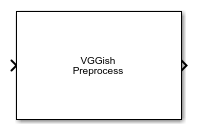VGGish Preprocess
Libraries:
Audio Toolbox /
Deep Learning
Description
The VGGish Preprocess block generates mel spectrograms from an audio input that you can then feed to the VGGish pretrained network or to a network that accepts the same inputs as VGGish.
Examples
Ports
Input
Output
Parameters
Block Characteristics
Data Types |
|
Direct Feedthrough |
|
Multidimensional Signals |
|
Variable-Size Signals |
|
Zero-Crossing Detection |
|
Algorithms
References
[1] Gemmeke, Jort F., Daniel P. W. Ellis, Dylan Freedman, Aren Jansen, Wade Lawrence, R. Channing Moore, Manoj Plakal, and Marvin Ritter. “Audio Set: An Ontology and Human-Labeled Dataset for Audio Events.” In 2017 IEEE International Conference on Acoustics, Speech and Signal Processing (ICASSP), 776–80. New Orleans, LA: IEEE, 2017. https://doi.org/10.1109/ICASSP.2017.7952261.
[2] Hershey, Shawn, Sourish Chaudhuri, Daniel P. W. Ellis, Jort F. Gemmeke, Aren Jansen, R. Channing Moore, Manoj Plakal, et al. “CNN Architectures for Large-Scale Audio Classification.” In 2017 IEEE International Conference on Acoustics, Speech and Signal Processing (ICASSP), 131–35. New Orleans, LA: IEEE, 2017. https://doi.org/10.1109/ICASSP.2017.7952132.
Extended Capabilities
Version History
Introduced in R2022a

